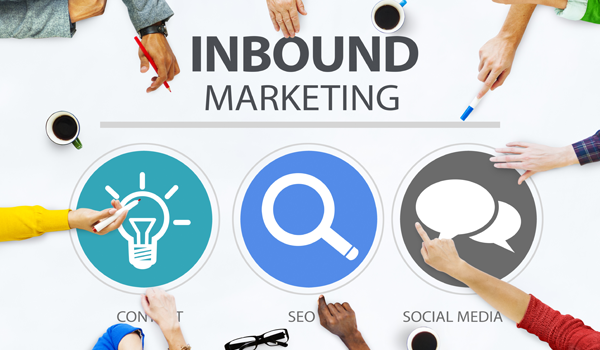To attract and delight customers online, five crucial steps are needed:
- Direct visitor traffic to your website
- Convert website visitors into contacts (Lead Generation)
- Nurture contacts through their purchasing decision process (Lead Nurturing)
- Prepare for the customer's purchase (Closing)
- Delight customers after the purchase (Delight)
1. Traffic – increase the number of visitors to your website
If you want to attract people to your own website, you first need to reach them wherever they are searching for information about their problems online. This means initially focusing not on your website itself but on upstream contact points such as search engines (especially Google), social media, and well-known websites like online magazines or blogs that your target audience frequently reads. Your chance of making new connections with potential customers depends on whether people resonate with your information online. The number of new customers you acquire is directly related to the number of contacts you make online. The more people see and read your offerings, the more customers you can ultimately generate. Therefore, it’s crucial that as many of your target customers as possible visit your website (website traffic), read your blog posts (blog traffic), and engage with your social media activities (social media traffic).
The more specific a visitor’s interest is, the more you need to satisfy their informational needs on your website. Search engines like Google have become one of the most important sources of traffic for websites. Those who do not know your website’s address (URL) will search for it through a search engine. And those who are not yet familiar with you can only find you through topic searches. However, people know that not every search engine results page (SERP) necessarily delivers what it promises. The top results on Google are not always the websites with the best and most useful content but sometimes those that have been specifically optimized for Google by SEO specialists. This is sometimes referred to as “Google Gaming.” Only when website visitors quickly leave because they are disappointed will Google start to push such web offerings further down in the search results due to negative user signals. But this takes time. We have examples where Google has kept SEO-optimized pages in the top ranks for more than a year, despite these pages being full of errors and content issues. Nevertheless, high-quality content typically prevails over the long term.
So how can you tell if you are successful in generating traffic? The visitor numbers for your website or blog will provide clear indicators. In part 3 of this book, we will show you exactly where to get this data and how to measure and analyze visitor streams. The key question at this stage is: How well is your traffic developing, and how does it compare to your competitors?
2. Leads – Generating and Qualifying the Right Prospects
People visit websites, blogs, and social media profiles for various reasons. Not everyone who visits your website intends to purchase your products or services. Competitors, interested students, journalists, and job seekers also visit your site. While all these visitors are important, their website traffic may be relatively worthless for your customer acquisition efforts. Even potential prospects visiting your site are not necessarily going to become customers right away. Initially, people often seek inspiration, print web content for later reference, or refine their needs by reviewing search results for different keywords.
So, find out how many and which of your website, blog, and social media visitors will engage in a personal dialogue with you. Try to convert your website visitors into identifiable contacts or leads. Why would website visitors want to engage with you? The answer lies in the relevance of your informational offering to each individual visitor. Your website may already contain valuable content that is freely accessible and has helped you achieve a good Google ranking for that page. Additionally, your site can offer content that is available only upon registration with contact details. The key is that an interested website visitor is willing to register in exchange for this content. The motivation of the website visitor should not only be immediate access to the specific content but also an interest in establishing a lasting dialogue with you. This is your true measure of success in lead generation. If you fail to achieve this, you may end up with a high percentage of alias and fake email addresses, indicating that you have not convinced visitors that a sustained dialogue with you is worthwhile.
The number of registrations for blogs and newsletters, the number of content downloads, and webinar registrations are quantitative measures of your lead generation success. Simultaneously, monitor the quality of the leads you acquire. What information have your new contacts provided to start a dialogue? Have you collected only names, email addresses, or additional information such as current decision-making needs or preferences? Your goal is to guide the most important contacts through their purchasing process. Therefore, you should aim to convert as much traffic as possible into valuable contacts and qualify them based on their needs. This lead nurturing is a continuous process. Pay close attention to how well and how quickly you qualify your leads. Consider this as an ongoing management function, known as Lead Management, in your organization. You will always need to refine your content offers, registration options for your prospects, and nurturing campaigns. Understanding the problem and the correct solution for your new contact (lead) is crucial.
Typically, the marketing department manages new contacts initially, maintaining dialogue until a clearer interest emerges (Marketing Qualified Lead). Sales colleagues then take over the dialogue at a defined point in the customer’s buying process, for example, when a specific purchase interest is indicated, such as downloading a price list on your website.
If a contact is moving towards a decision and comparing various providers, they may already be a qualified lead for your sales team (Sales Qualified Lead). The sales team then works to address any remaining purchase barriers and increase the likelihood of a quick purchase decision. This is a multi-stage process that can span months, depending on the customer profile and products, such as machinery and industrial equipment. Your central success question here is: How effectively does your company convert incoming traffic into interested prospects who initiate contact and dialogue with your company?
3. Customers – More of Them, But Only the Right Ones
The central goal of your customer acquisition is, of course, closing sales with new customers. But that’s not the end of it. Your task is also to ensure that the purchased products and services are used to the customer's full satisfaction. Customer satisfaction is the basis for making repeat purchases and additional sales during the product's lifecycle.
However, not every sale is a successful sale. Nothing is worse than gaining new customers only to find out later that dissatisfied customers use the purchased product little or not at all, or in the worst case, stop using it quickly. For many services (from doctors to consultants) and online-based products (SaaS software), where customers rent on a monthly basis, customer churn is always possible and thus prevention in the form of churn prevention is of existential importance. There are plenty of examples where new sales were achieved successfully, but it was not properly monitored whether the right customers were acquired. You gain nothing if your sales figures are excellent but many customers express dissatisfaction or even cancel after the purchase. This happens when you produce wonderful content and provide problem-solving advice, but then fall short of the high expectations set by customers with the actual product performance. Or when you simply fail to match the right customers with the right products. Inbound marketing then easily becomes a boomerang. The key question here is: How well does your company convert prospects into actual new customers? And how profitable are these customers or sales?
4. Advocates – After acquiring customers, it's time for the next round of customer acquisition
Even the number of newly acquired customers is not the ultimate goal of your customer acquisition efforts. The ultimate aim of Inbound Marketing is to create a maximum number of satisfied and enthusiastic customers who actively recommend your company and your offerings. It's about advocates or fans. When you have a steady number of advocates and fans, the loop closes, and your Inbound Marketing starts to work more and more on its own, as your loyal customers and fans take over the task of building new contacts. Look at how strongly and by whom your posts are shared and liked on social media. Analyze what recommendations from satisfied customers can achieve. Do your customers share your content in their network or even name relevant prospects to you? Do they recommend you and your offerings to entire groups or just to individuals with personal recommendations? How well do you support your customers in their advocacy for your company? In Part 3 of this book, you'll learn everything about this crucial final phase of Inbound Marketing.
Inbound Example: HeadSpace Turns Enthusiastic Customers into Advocates
A vivid example of how to activate customers as advocates is demonstrated by the paid meditation app HeadSpace. Users of the free version can use basic features of the product and start with initial meditation exercises. When a user upgrades to the paid full version and achieves certain milestones, such as completing a meditation for ten consecutive days, they receive a free month of the full version to share with a friend. The paying user is notified by email, where HeadSpace congratulates them on their successful first step in their meditation practice and encourages them to share this positive experience with a friend. This gives the paying customer an unexpected motivation, a price advantage, and a charming invitation to actively recommend the product within their network. The customer becomes enthusiastic about the brand and, simultaneously, an advocate and fan.
The more you delve into inbound marketing, the more you might be surprised to find that some companies or agencies simply ignore this phase or treat it half-heartedly. This is economically irrational. Your inbound marketing will only become a profitability booster for your company when your customers actively engage in acquiring new customers for you both online and offline, thereby even reducing your customer acquisition costs. The crucial question here is: How many of your customers can be so excited that they become active advocates and fans of your brand?


